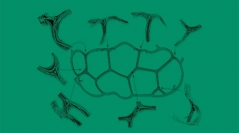

 Comptes Rendus Palevol
22 (4) - Pages 45-57
Comptes Rendus Palevol
22 (4) - Pages 45-57The long ranging Silurian retiolitines belonging to the Paraplectograptus lineage (Spirograptus turriculatus to Cyrtograptus/lundgreni Biozone), represented by the genera Paraplectograptus Bouček & Münch, 1952 and Pseudoplectograptus Obut & Zaslavskaya, 1983 are described in detail based on well preserved, three-dimensional material from the Canadian Arctic and Poland. For the first time, reconstructions of their structure are attempted, and comparisons are made with the related genera, Stomatograptus Tullberg, 1883 and Retiolites Barrande, 1850. Ultrastructural details vary somewhat between the genera: the bandaging on the Paraplectograptus lineage and Pseudoplectograptus has a characteristic pustulose ornament, while that of Retiolites and Stomatograptus shows a surface of longitudinal striations. Prosicular preservation is generally incomplete, represented merely by the prosicular apex and prosicular rim. The thecal part of the Paraplectograptus and Pseudoplectograptus tubaria (rhabdosomes) possesses transverse rods, connecting rods, lateral apertural rods and lips. The ancora sleeve lists are variably developed but lack a dorsal/zigzag list, which is present in Stomatograptus and Retiolites. The Paraplectograptus lineage appears to mark an intermediate stage in the evolution of the retiolitines, from the early Silurian forms, with strong thecal and ancora sleeve frameworks (e.g. Retiolites, Stomatograptus), to late Silurian descendants with strong ancora sleeves, minimal thecal frameworks and pustular ornament, with no transverse rods.
Graptolithina, Retiolitinae, Paraplectograptus, Silurian, tubarium (rhabdosome) morphology, reconstruction